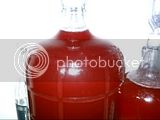Started a 3 gallon batch of Kellers Dried Cranberry two nights ago. I put the Brew Belt on her as the basement temp is mid to low 60s lately. I followed the recipe to the letter, but am tempted to add vanilla. This is one of two batches for 2006 holiday season.

The other batch of cranberry was Kellers cran/currant which I oaked for 4 weeks with french cubes. It's smelling pretty nice so far.

This is the first time I am using the Brewers Belt. It's a plastic pail. I felt it a few times and it seems like it won't be trouble. Any advice?

The other batch of cranberry was Kellers cran/currant which I oaked for 4 weeks with french cubes. It's smelling pretty nice so far.

This is the first time I am using the Brewers Belt. It's a plastic pail. I felt it a few times and it seems like it won't be trouble. Any advice?









